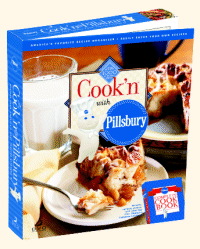
|
Never miss another recipe... Sign up for our free monthly newsletter today!
Subscribing will not result in more spam! I guarantee it! NEWSLETTER
• Current Issue• Newsletter Archive • Sign Up Now 
Cook'n with Betty Crocker 
Cook'n with Pillsbury 
Cook'n with a Taste of Home 
Cook'n in Italy 
Cook'n in Mexico |
 |
Understanding Cholesterol |
|
Print this Recipe What is cholesterol? Cholesterol is a soft, waxy, fat-like substance produced by the liver. The body makes 800 to 1,500 milligrams of cholesterol each day, which circulates through the bloodstream. Cholesterol has many functions: * It is an essential part of every cell in your body. * It helps to produce certain hormones, such as estrogen. * It is a vital part of your nervous system and brain. * Through sunlight, it is converted to vitamin D in your skin. * It helps in the digestion and absorption of fat. While your body makes its own cholesterol, there is also cholesterol in the food we eat. Dietary cholesterol (the cholesterol in food) is found only in animal foods, such as sheese, meat, butter and eggs. Plant foods grains, fruits, vegetables, nuts do not contain cholesterol. Unlike fat, cholesterol does not contain any calories, nor is it a source of energy. About one-third of Americans is sensitive to dietary cholesterol, meaning that eating foods high in cholesterol raises cholesterol levels in the blood. Currently there is no test to determine if you are the sensitive type, therefore, health experts recommend everyone choose a diet that contains no more than 300 milligrams of cholesterol each day. The easiest way to control dietary cholesterol is to learn which foods are high sources. The most concentrated sources of dietary cholesterol are organ meats, such as liver, brain and kidney, egg yolks and some high-fat dairy products, such as sour cream. (The table beginning on page 225 lists the cholesterol content of some familiar foods.) Compare the different foods so you will be able to choose wisely. What’s Your Cholesterol Number? Measuring blood to determine the amount of cholesterol in it helps screen people for their risk for heart disease. For some people, however, just knowing total blood cholesterol may not be enough; finding out about LDL and HDL levels is also necessary. (See The Skinny of HDLs and LDLs on page 10.) This is especially true for people whose total blood cholesterol is considered borderline-high (above 200 milligrams per deciliter of blood) and high (above 240 milligrams). Physicians often will obtain LDL and HDL readings for nearly all their patients. A blood profile can determine the levels of LDLs and HDLs. This type of analysis may be advisable for people with borderline-high cholesterol levels plus two risk factors for heart disease (see table below). Some physicians may calculate a ratio between HDL and total cholesterol. This is another approach to determining heart disease risk. However, the American Heart Association recommends focusing on absolute numbers for total blood cholesterol and HDL cholesterol levels. A direct relationship exists between total blood cholesterol and LDL cholesterol, meaning as total blood cholesterol increases, so does LDL cholesterol. Three known causes of a high LDL and blood cholesterol level are: * Genetic factors and family history * A diet high in saturated fats and cholesterol * Health conditions, such as diabetes, diseases of the liver and kidney or an underactive thyroid. Just as heart disease risk increases with a high LDL and total blood cholesterol level, a low level of HDLs may indicate an increased risk for heart disease even if your total cholesterol is below 200 mg/dl. Some possible causes include lack of exercise, obesity, smoking and high blood cholesterol and/or triglycerides (another type of fat in the blood). More than 50 percent of all adult Americans have blood cholesterol levels higher than 200 mg/dl, the “desirable” level; half of these people have levels above 240 mg/dl. Their risk for heart disease is double that of people whose cholesterol is below 200 mg/dl. From "Betty Crocker's Low-Fat, Low-Cholesterol Cooking Today." Text Copyright 2005 General Mills, Inc. Used with permission of the publisher, Wiley Publishing, Inc. All Rights Reserved. This recipe comes from the Cook'n collection. Try Cook'n for FREE! Here’s to your health Fat Facts Understanding Cholesterol Other Important Nutrients Putting It All Together Reading a Nutrition Label Go Slow For Success Test Your Health IQ The Skinny on Fat Cholesterol Trimming Tips Nutritional Comparison |
|
|
Affiliate Program | Privacy Policy | Other Resources | Contact Us
© 2008 DVO Enterprises, Inc. All rights reserved. Sales: 1-888-462-6656 |

